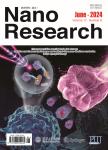Durable, superhydrophobic, antireflection, and low haze glass surfaces using scalable metal dewetting nanostructuring
Durable, superhydrophobic, antireflection, and low haze glass surfaces using scalable metal dewetting nanostructuring作者机构:ICFO-Institut de Ciencies Fotbniques Av. Carl Friedrich Gauss 3 08860 Castelldefels Barcelona Spain ICREA-Institucio Catalana de Recerca i Estudis Avan~ats Passeig Llu/s Companys 2308010 Barcelona Spain Coming Incorporated Sullivan Park Coming NY 14831 USA
出 版 物:《Nano Research》 (纳米研究(英文版))
年 卷 期:2013年第6卷第6期
页 面:429-440页
核心收录:
学科分类:081704[工学-应用化学] 07[理学] 070304[理学-物理化学(含∶化学物理)] 08[工学] 0817[工学-化学工程与技术] 0805[工学-材料科学与工程(可授工学、理学学位)] 080502[工学-材料学] 0703[理学-化学]
基 金:supported by the Spanish Ministerio de Economia y Competitividad through grant
主 题:nanostructures surface modification antireflective superhydrophobic/philicsurfaces self-assembly dewetting
摘 要:In this paper we report a multifunctional nanostructured surface on glass that, for the first time, combines a wide range of optical, wetting and durability properties, including low omnidirectional reflectivity, low haze, high transmission, superhydrophobicity, oleophobicity, and high mechanical resistance. Nanostructures have been fabricated on a glass surface by reactive ion etching through a nanomask, which is formed by dewetting ultrathin metal films (〈 10 nm thickness) subjected to rapid thermal annealing (RTA). The nanostructures strongly reduce the initial surface reflectivity (-4%), to less than 0.4% in the 390--800 nm wavelength range while keeping the haze at low values (〈 0.9%). The corresponding water contact angle (0c) is -24.5~, while that on a flat surface is -43.5~. The hydrophilic wetting nanostructure can be changed into a superhydrophobic and oleophobic surface by applying a fluorosilane coating, which achieves contact angles for water and oil of -156.3~ and -116.2~, respectively. The multicomponent composition of the substrate (Coming~ glass) enables ion exchange through the surface, so that the nanopillars' mechanical robustness increases, as is demonstrated by the negligible changes in surface morphology and optical performance after 5,000-run wipe test. The geometry of the nanoparticles forming the nanomask depends on the metal material, initial metal thickness and RTA parameters. In particular we show that by simply changing the initial thickness of continuous Cu films we can tailor the metal nanoparticles' surface density and size. The developed surface nanostructuring does not require expensive lithography, thus it can be controlled and implemented on an industrial scale, which is crucial for applications.



